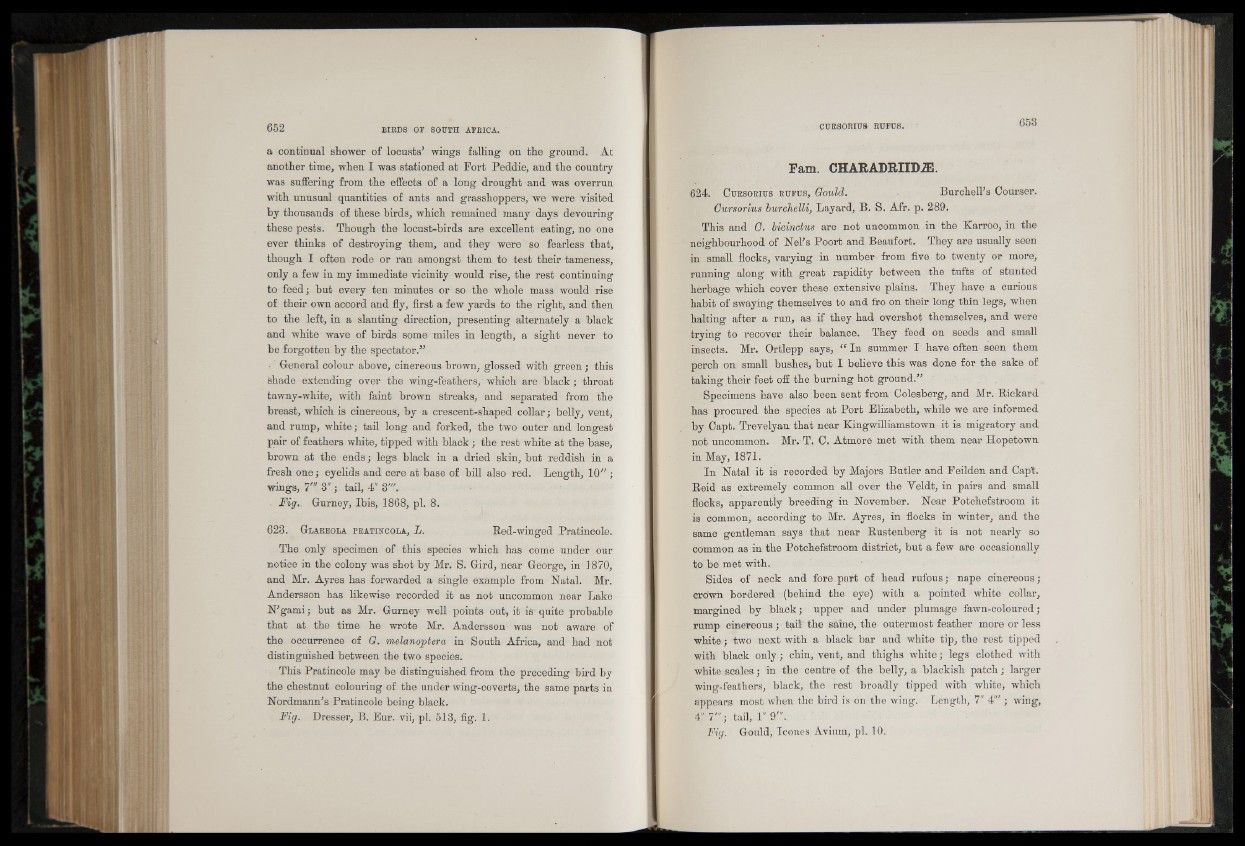
a continual shower of locusts* wings falling on the ground. Ac
another time, when I was stationed at Port Peddie, and the country
was suffering from the effects of a long drought and was overrun
with unusual quantities of ants and grasshoppers, we were visited
by thousands of these birds, which remained many days devouring
these pests. Though the locust-birds are excellent eating, no one
ever thinks of destroying them, and they were so fearless that,
though I often rode or ran amongst them to test their tameness,
only a few in my immediate vicinity would rise, the rest continuing
to feed; but every ten minutes or so the whole mass would rise
of their own accord and fly, first a few yards to the right, and then
to the left, in a slanting direction, presenting alternately a black
and white wave of birds some miles in length, a sight never to
be forgotten by the spectator.**
General colour above, cinereous brown, glossed with green; this
shade extending over the wing-feathers, which are black; throat
tawny-white, with faint brown streaks, and separated from the
breast, which is cinereous, by a crescent-shaped collar; belly, vent,
and rump, white; tail long and forked, the two outer and longest
pair of feathers white, tipped with black; the rest white at the base,
brown at the ends; legs black in a dried skin, but reddish in a
fresh one; eyelids and cere at base of bill also red. Length, 10*';
wings, 7'" 3"; tail, 4" S'"..
Fig. Gurney, Ibis, 1868, pi. 8.
623. G l a r e o l a p r a t i n c o l a , L . Red-winged Pratincole.
The only specimen of this species which has come under our
notice in the colony was shot by Mr. S. Gird, near George, in 1870,
and Mr. Ayres has forwarded a single example from Natal. Mr.
Andersson has likewise recorded it as not uncommon near Lake
N*gami; but as Mr. Gurney well points out, it is quite probable
that at the time he wrote Mr. Andersson was not aware of
the occurrence of G. melanaptera in South Africa, and had not
distinguished between the two species.
This Pratincole may be distinguished from the preceding bird by
the chestnut colouring of the under wing-coverts, the same parts in
Nordmann’s Pratincole being black.
Fig. Dresser, B. Eur. vii, pi. 513, fig. 1.
Fam. CHARADRIID2E.
624. C ursorius ru fu s , Gould. Burchell’s Courser.
Gursorius burchelli, Layard, B. S. Afr. p. 289.
This and 0. bicinctus are not uncommon in the Karroo, in the
neighbourhood of NeTs Poort and Beaufort. They are usually seen
in small flocks, varying in number from five to twenty or more,
running along with great rapidity between the tufts of stunted
herbage which cover these extensive plains. They have a curious
habit of swaying themselves to and fro on their long thin legs, when
halting after a run, as if they had overshot themselves, and were
trying to recover their balance. They feed on seeds and small
insects. Mr. Ortlepp says, “ In summer I have often seen them
perch on small bushes, but I believe this was done for the sake of
taking their feet off the burning hot ground.*’
Specimens have also been sent from Colesberg, and Mr. Rickard
has procured the species at Port Elizabeth, while we are informed
by Capt. Trevelyan that near Kingwilliamstown it is migratory and
not uncommon. Mr.-T. C. Atmore met with them near Hopetown
in May, 1871.
In Natal it is recorded by Majors Butler and Peilden and Capt.
Reid as extremely common all over the Yeldt, in pairs and small
flocks, apparently breeding in November. Near Potchefstroom it
is common, according to Mr. Ayres, in flocks in winter, and the
same gentleman, says that near Rustenberg it is not nearly so
common as in the Potchefstroom district, but a few are occasionally
to be met with.
Sides of neck and fore part of head rufous; nape cinereous;
crown bordered (behind the eye) with a pointed white collar,
margined by black; upper and under plumage fawn-coloured;
rump cinereous ; tail the sainé, the outermost feather more or less
white; two next with a black bar and white tip, the rest tipped
with black only; chin, vent, and thighs white; legs clothed with
white scales; in the centre of the belly, a blackish patch; larger
wing-feathers, black, the rest broadly tipped with white, which
appears most when the bird is on the wing. Length, 7" 4"'; wing,
4" T "; tail, 1" 9'"..
Fig. Gould, leones Avium, pi. 10.